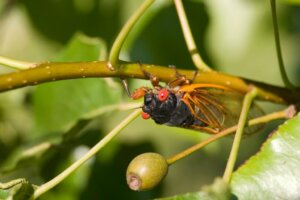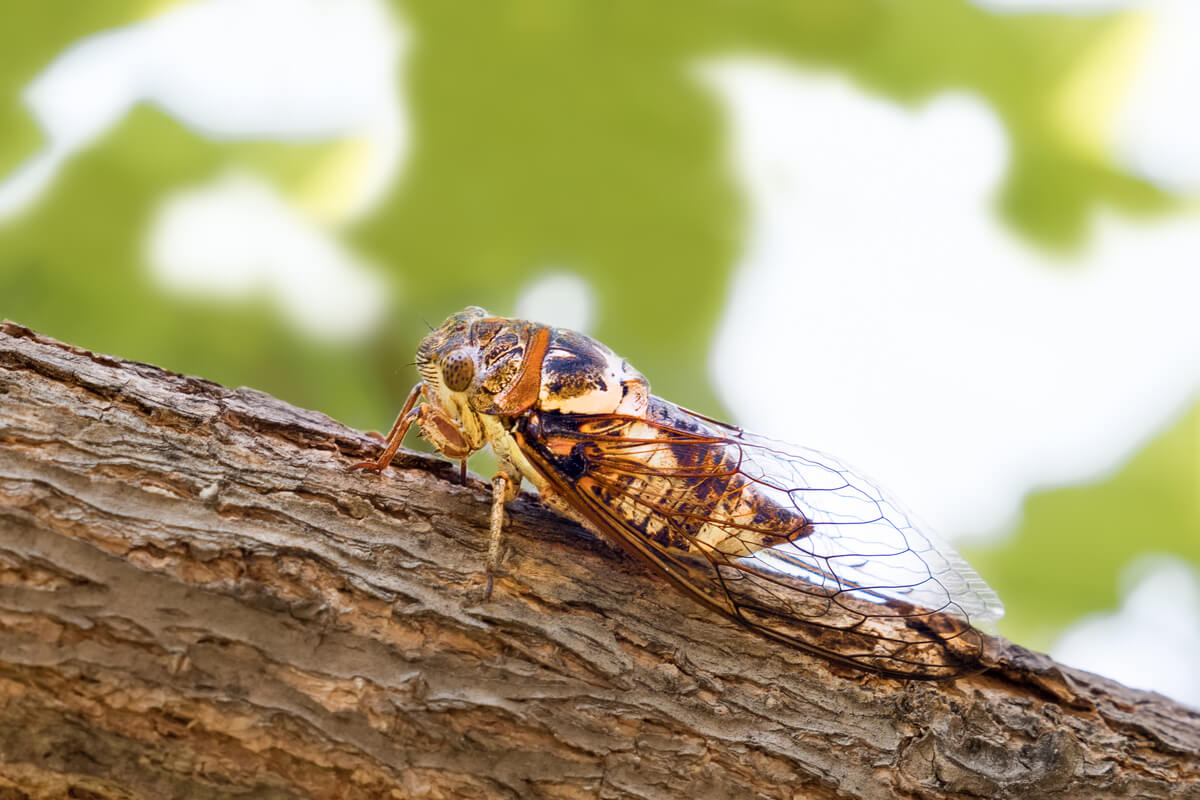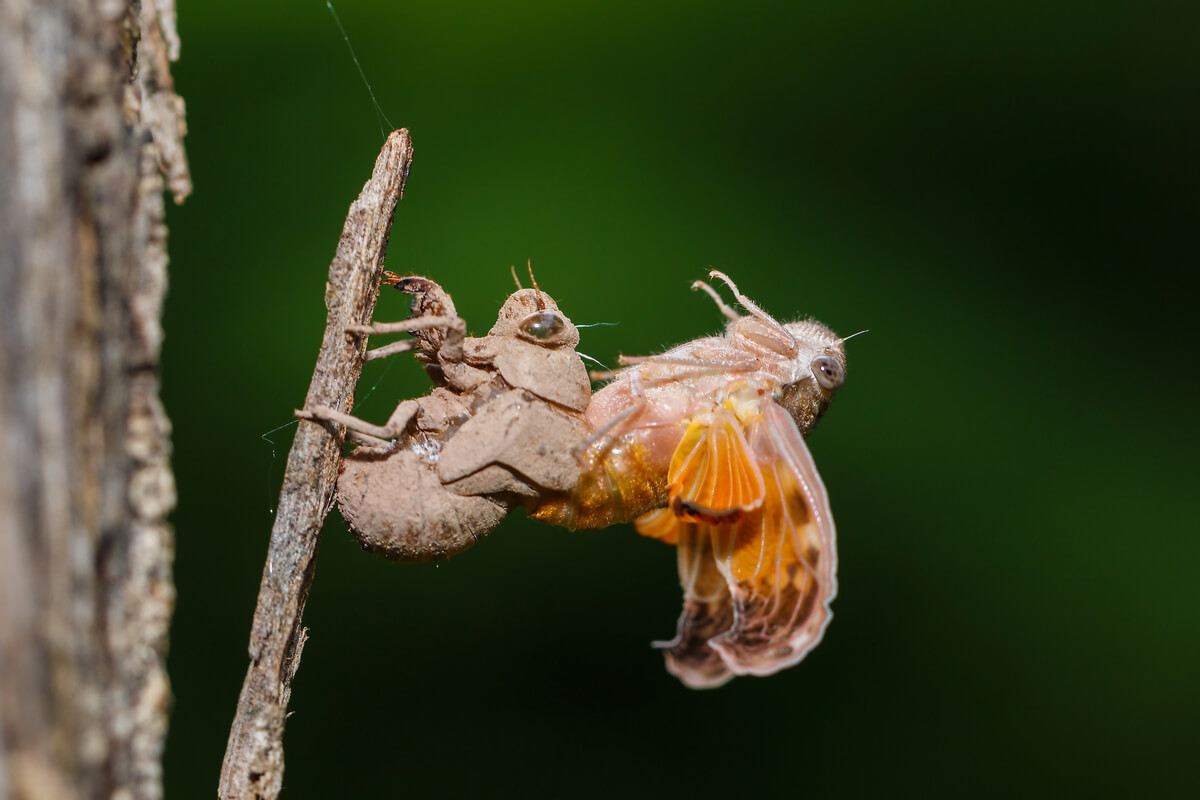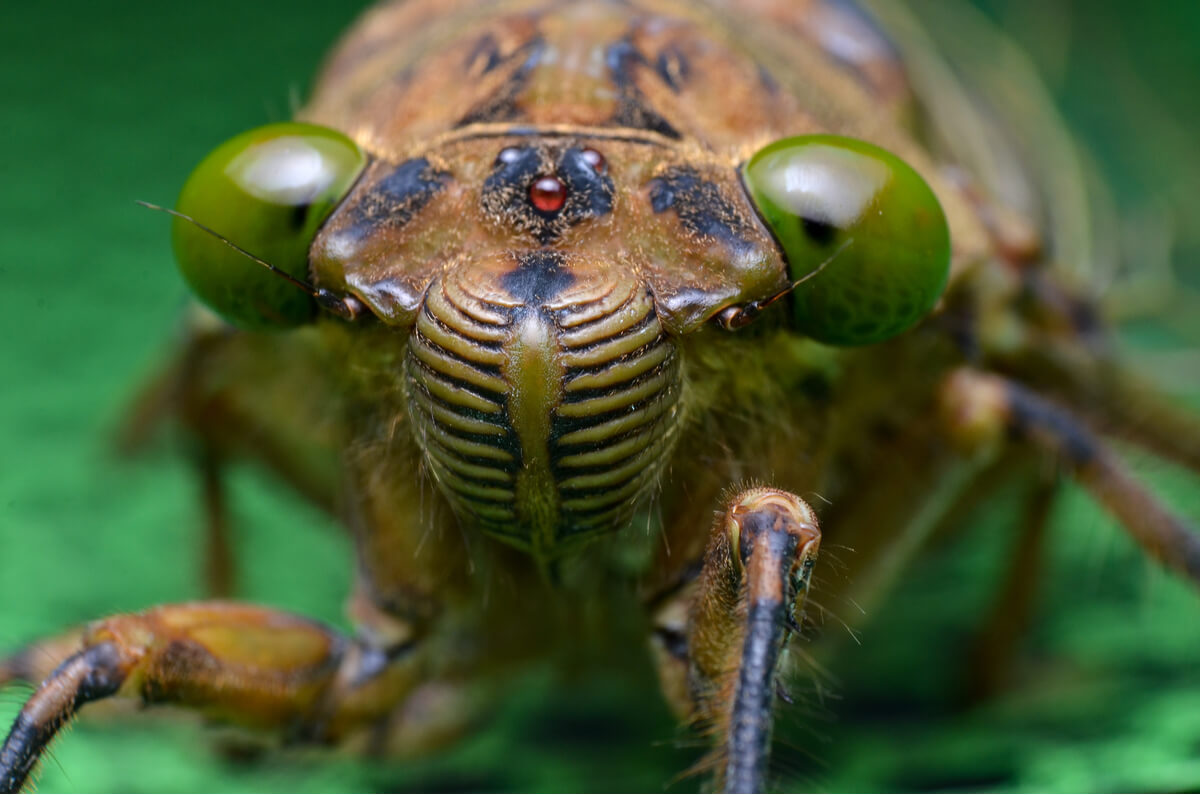Cicadas: Habitat and Characteristics

Do you remember when you first walked in the countryside and heard those strange sounds that were far removed from the typical street noises? You were probably listening to the “song” of the cicadas. However, do you know what group of animals cicadas belong to?
Cicadas are winged insects that occupy practically the entire planet, with more than 3,200 species described to date. If you want to know more about them, then keep reading.
Cicada habitat
Cicadas are part of the Cyclacid family (Cicacidae), which, in turn, is included in the Hemiptera. As they belong to this group, they’re related to other hemiptera, such as bed bugs and aphids, which are well-known and have a bad reputation.
On the other hand, these insects are known by different names according to the regions they live in. For example, in South America, they’re called ‘chicharras’ or ‘cocuyos’. Regarding their distribution, they’re located in every continent of the world, with the exception of Antarctica.
Cicadas are present in both hot and cold areas, with an altitude that varies from the seashore to 3,000 meters (10000 feet).

Characteristics and feeding
Each region has its own name for these animals, which can be referred to as ‘chicharras’, ‘cocuyos’ or ‘chiquilichis’, among others. Here are some defining features of this family.
They have sucking mouthparts and ocelli
Despite so many names, they‘re recognizable by their shape and size. Cicadas are between 15-66 millimeters long and have a characteristic shade of brown, black, gray or green. As for their eyes, they appear to have two, but, in reality, they have five, with about three simple triangular eyes (ocelli) beyond the compound ones, located on each side.
On their head there’s also a suction mouthpiece, with which they feed on the sap. After hatching, the nymphs fall to the ground and burrow into it. In this way, they feed on the sap of the roots and the adults on the vegetables. They can live between 2 and 17 years.
Cicadas don’t sing, they shriek
Like crickets, cicadas “stridulate,” that is, they make a shrill sound. When they emit this sound, they seem to announce the arrival of Holy Week or Lent in the central countries of South America. On the other hand, in North America, cicadas appear with the arrival of summer.
We normally associate singing with the lungs, but, in this case, “breathing” with the abdomen is the key. In the case of cicadas, they generate their song through certain structures, which function as resonance boxes. These boxes are located in the abdomen and are filled and emptied of air, through membranes known as ‘timpani’.
Furthermore, males sing only during courtship – to attract the females – and each species of cicada has its own sound. Although to most they all sound the same, this isn’t the case. There are actually thousands of different species of cicadas, all with a unique sound.
Some species emerge every 17 years
Every 17 years, there’s a massive emergence of specimens of the genus Magicicada in the United States. According to experts, this behavior is a clear survival technique. It appears that this timing ability allows cicadas to avoid predators and avoid extinction. Furthermore, it’s believed that this adaptation could be related to solar radiation.

Curiosities of the cicadas
It’s also very interesting to find out about different curiosities regarding these “singing” insects, which are part of different cultures all around the world.
Although cicadas are deaf, they give rock concerts
It has already been mentioned that male cicadas are the only ones that “sing”, as they use this sound to lure the females. However, cicadas are deaf, and so it seems counterintuitive for them to use song to attract each other. However, there’s an explanation for this: the females are attracted by the vibrations of the sound that the male produces!
Experts have calculated that the “song” of the cicadas can reach up to 115 decibels, which classifies it among the loudest sounds in the world. People have even compared it to a rock concert!
A part of many cultures
When traveling the different continents of the world, this insect forms a central part of different cultures, such as the Asian or American. They’re considered symbols of immortality and have served as the basis for many popular beliefs.

In short, cicadas are apparently simple insects on the outside, but they hide a great behavioral complexity. Not only are some of them able to reach 17 years of age, but they can fill entire fields with their song.
Finally, it should be noted that they’re completely harmless. They don’t bite nor harm humans, and so there’s no excuse not to respect these invertebrates. If we continue to live with them in peace, we’ll be able to enjoy their songs for a long time yet.
Do you remember when you first walked in the countryside and heard those strange sounds that were far removed from the typical street noises? You were probably listening to the “song” of the cicadas. However, do you know what group of animals cicadas belong to?
Cicadas are winged insects that occupy practically the entire planet, with more than 3,200 species described to date. If you want to know more about them, then keep reading.
Cicada habitat
Cicadas are part of the Cyclacid family (Cicacidae), which, in turn, is included in the Hemiptera. As they belong to this group, they’re related to other hemiptera, such as bed bugs and aphids, which are well-known and have a bad reputation.
On the other hand, these insects are known by different names according to the regions they live in. For example, in South America, they’re called ‘chicharras’ or ‘cocuyos’. Regarding their distribution, they’re located in every continent of the world, with the exception of Antarctica.
Cicadas are present in both hot and cold areas, with an altitude that varies from the seashore to 3,000 meters (10000 feet).

Characteristics and feeding
Each region has its own name for these animals, which can be referred to as ‘chicharras’, ‘cocuyos’ or ‘chiquilichis’, among others. Here are some defining features of this family.
They have sucking mouthparts and ocelli
Despite so many names, they‘re recognizable by their shape and size. Cicadas are between 15-66 millimeters long and have a characteristic shade of brown, black, gray or green. As for their eyes, they appear to have two, but, in reality, they have five, with about three simple triangular eyes (ocelli) beyond the compound ones, located on each side.
On their head there’s also a suction mouthpiece, with which they feed on the sap. After hatching, the nymphs fall to the ground and burrow into it. In this way, they feed on the sap of the roots and the adults on the vegetables. They can live between 2 and 17 years.
Cicadas don’t sing, they shriek
Like crickets, cicadas “stridulate,” that is, they make a shrill sound. When they emit this sound, they seem to announce the arrival of Holy Week or Lent in the central countries of South America. On the other hand, in North America, cicadas appear with the arrival of summer.
We normally associate singing with the lungs, but, in this case, “breathing” with the abdomen is the key. In the case of cicadas, they generate their song through certain structures, which function as resonance boxes. These boxes are located in the abdomen and are filled and emptied of air, through membranes known as ‘timpani’.
Furthermore, males sing only during courtship – to attract the females – and each species of cicada has its own sound. Although to most they all sound the same, this isn’t the case. There are actually thousands of different species of cicadas, all with a unique sound.
Some species emerge every 17 years
Every 17 years, there’s a massive emergence of specimens of the genus Magicicada in the United States. According to experts, this behavior is a clear survival technique. It appears that this timing ability allows cicadas to avoid predators and avoid extinction. Furthermore, it’s believed that this adaptation could be related to solar radiation.

Curiosities of the cicadas
It’s also very interesting to find out about different curiosities regarding these “singing” insects, which are part of different cultures all around the world.
Although cicadas are deaf, they give rock concerts
It has already been mentioned that male cicadas are the only ones that “sing”, as they use this sound to lure the females. However, cicadas are deaf, and so it seems counterintuitive for them to use song to attract each other. However, there’s an explanation for this: the females are attracted by the vibrations of the sound that the male produces!
Experts have calculated that the “song” of the cicadas can reach up to 115 decibels, which classifies it among the loudest sounds in the world. People have even compared it to a rock concert!
A part of many cultures
When traveling the different continents of the world, this insect forms a central part of different cultures, such as the Asian or American. They’re considered symbols of immortality and have served as the basis for many popular beliefs.

In short, cicadas are apparently simple insects on the outside, but they hide a great behavioral complexity. Not only are some of them able to reach 17 years of age, but they can fill entire fields with their song.
Finally, it should be noted that they’re completely harmless. They don’t bite nor harm humans, and so there’s no excuse not to respect these invertebrates. If we continue to live with them in peace, we’ll be able to enjoy their songs for a long time yet.
All cited sources were thoroughly reviewed by our team to ensure their quality, reliability, currency, and validity. The bibliography of this article was considered reliable and of academic or scientific accuracy.
- MNCR-EDITOR-MARIBEL. (2020, 26 agosto). Las Chicharras « Artículos Educativos «. Museo Nacional de Costa Rica. https://www.museocostarica.go.cr/divulgacion/articulos-educativos/las-chicharras/
- Serie Catálogo. Museo Provincial de Ciencias Naturales «Florentino Ameghino». Santa Fe. Argentina. (2007, 1 julio). CICÁCIDOS (INSECTA:HEMIPTERA:CICADIDAE) DEL MUSEO PROVINCIAL DE CIENCIAS NATURALES «FLORENTINO AMEGHINO» SANTA FE, ARGENTINA. ResearchGate. http://www.museoameghino.gob.ar/archivos/repositorios/126_descarga_82_de_santis_cecilia_celeste_medrano_allen_f_sanborn_y_pablo_bolcatto.pdf
This text is provided for informational purposes only and does not replace consultation with a professional. If in doubt, consult your specialist.








